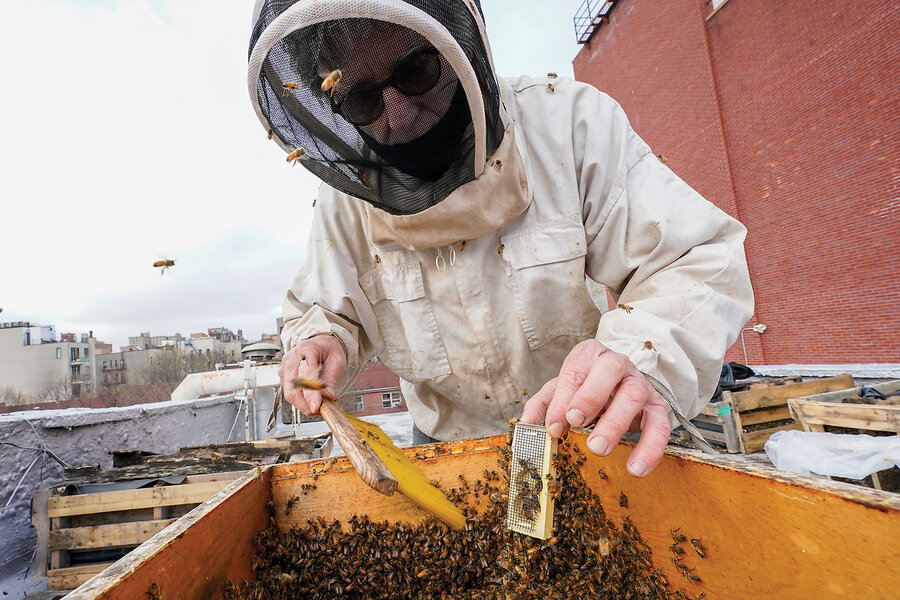
Domesticated honeybee populations are at an all-time high
Since 2006, steep winter losses of worker bees have spurred scientists and the U.S. government to try to understand colony collapse disorder. Honeybees pollinate four-fifths of all flowering plants, which makes one-third of the food system dependent on bees.
But new data from the Census of Agriculture shows that honeybee colonies have increased by 1 million in the last five years, for a total of 3.8 million.
Why We Wrote This
In our progress roundup, new data shows workers undergirding vital systems: In Latin America, Venezuelans who’ve fled their own country boost the gross domestic product in their adopted homes. And in the United States, bees colonies have grown.
Because the tally includes colonies on any plot of land that makes over $1,000 a year from agricultural products, higher honey prices may have pushed some hobbyists’ bees into the count. Part of the increase is also attributed to tax breaks for bee colonies on farms in Texas, which now has the highest number of operations in the U.S.
Experts emphasize that feral bees and other wild pollinators still need more support, such as reduced pesticide use and more flower-rich habitats.
Source: The Washington Post
Venezuelans are boosting economies where they’ve immigrated
Since Venezuela’s economy collapsed in 2014, nearly 8 million people have fled poverty and turmoil, seeking refuge across Latin America. Two studies from institutions including the World Bank and the United Nations refugee agency found that the new workforce, which includes displaced people from countries in addition to Venezuela, would boost gross domestic product in host nations by 0.10% to 0.25% on average each year from 2017 until 2030.
Over time, economic growth from migrants’ contributions outstrips state spending on public services provided to newcomers, the studies found. Immigrants fill labor shortages for less-desirable jobs, and their spending can drive demand for goods and services.
Xenophobia and a lack of recognition of Venezuelans’ credentials have led to underemployment of professionals, and many lack access to social services such as health insurance. The studies argue that countries could further improve productivity by better integrating new arrivals.
Sources: The Guardian, The Conversation
Chemists in Switzerland created a sustainable plastic from agricultural waste
Plastic production is responsible for 3.4% of global greenhouse gas emissions, and because plastic never biodegrades, it is a major source of environmental pollution. A team at Switzerland’s federal technology institute used a sugar structure commonly found in biomass to produce a class of strong plastics with little waste.
The team’s catalyst-free process uses dimethyl glyoxylate xylose, a carbohydrate created from agriculture leftovers such as wood and corncobs, to create polyamides – a class of plastics that includes nylon and is known for durability and strength. The new plastic maintained integrity through several mechanical recycling cycles, meaning it can be used multiple times.
The new plastic could be used to create everything from car parts to consumer goods. The team’s analysis suggests that the material is competitive with traditional polyamides. In 2019, the university spun off a startup that will be able to scale up production of the new material.
Sources: Swiss Federal Institute of Technology Lausanne, Nature Sustainability
Traditional practices are keeping agriculture sustainable in Oman, a country of mostly deserts
In the Hajar Mountains, thousands of years of skillful water and soil management have allowed people to grow a wide variety of foods, from date palms to carrots.
Through an ancient system of irrigation known as aflaj, water is channeled from mountain springs and pools to terraced fields. For hundreds of years, farmers have mixed river sediment with manure from goats raised on the land to create the terrace soil.
Though climate change and shifting socioeconomic forces in the developed country threaten Oman’s oasis agriculture, new crops such as olives are taking off, and crop diversity remains high. Andreas Bürkert, a professor of agroecosystems, warns of the need to maintain traditional knowledge but sees the local ways as “a model for sustainability. … It’s the only place in the world I know of where 1,500 years of irrigated agriculture … has not led to salinization,”
he said.
Source: Mongabay
A Nigerian radio show mediates grievances for citizens with little power and delivers a sense of justice
In Sokoto state, nearly 90% of the population lives below the poverty line, and three-quarters are unable to read or write English – Nigeria’s official language. That can make navigating the legal system difficult. “Kukana,” a weekly show airing on Sokoto’s Vision FM, researches complaints and often puts the aggrieved party on the air with a lawyer.
Hosts say “Kukana,” whose name roughly translates to “my woes,” attracts more than 1.7 million listeners. One week, members of Sokoto’s Joint Disabled Association discussed the sudden cessation of their government benefits. The governor visited the coalition after hearing the show, and the stipends soon restarted.
In the capital, Abuja, a similar program, “Brekete Family,” invites people to share their problems on television and radio, and provides connections to relevant authorities.
Source: Reasons to be Cheerful


